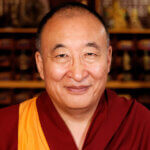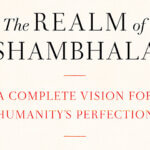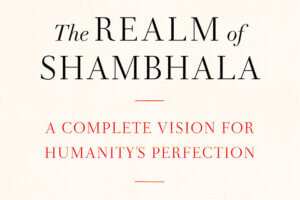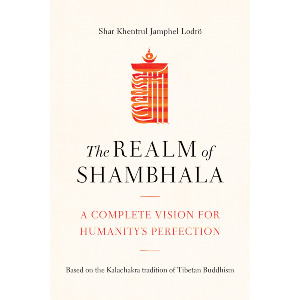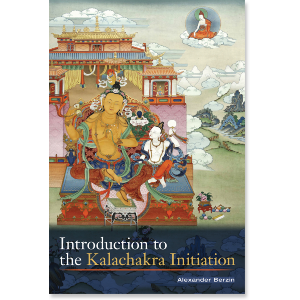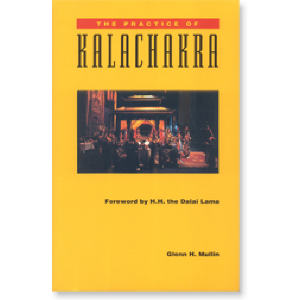Realize the Ultimate Manifestation
An excerpt from The Realm of Shambhala
The Society of Shambhala
To be born in Shambhala, one must have produced a significant amount of merit through intensive spiritual practice. This means that every citizen starts their lives endowed with a wealth of virtuous qualities. In particular, they all have phenomenal propensities for love and compassion.
Each child is born to a human mother, but, unlike ordinary birth, there is no pain. While both parents feel an enormous amount of love for their children, they do not view them as their own; instead, they love all children equally, regardless of who physically gave birth to them. In this way, family boundaries are based primarily on proximity and not so heavily on biology. As long as a child needs them, there are adults who are capable of offering support and nurturing them.
The people of Shambhala focus all of their energy on developing their spiritual capacities.
From a very early age, children are introduced to the spiritual views emphasized in their particular region. While all spiritual systems in Shambhala are considered to be a part of Kalachakra, different methods are recognized to be more effective for certain types of people. As a result, the specific propensities of a child will determine where exactly in Shambhala they are born; therefore, each child is guaranteed to encounter the spiritual practices best suited for their needs.
Due to their extremely well-developed spiritual qualities, children progress very quickly along their respective paths. Like riding a bicycle, they relearn much of what they were taught in previous lives and so are able to develop deep levels of meditative absorption at a very young age. These advanced states of mind bestow a wide variety of mundane attainments, or siddhis, on the practitioners, allowing them to perform extraordinary feats, such as moving over great distances in just a few moments or manifesting many types of psychic capacities. Since food, clothing, and shelter are available in abundance, there is no need for anyone to work for money or for people to trade in goods. No markets or economies are required. Consequently, the people of Shambhala focus all of their energy on developing their spiritual capacities.
The leaders of the various kingdoms do not need to impose laws on their people.
The human body in such a society is viewed as a sacred and powerful support for achieving realizations. Bodies are not regarded on the basis of desire or lust; rather, people learn how to use their sexuality in a constructive and beneficial way. Sex itself is not seen as something to be ashamed of nor as something to be attached to. It is something to be respected and valued as an important aspect of spiritual development. Sexuality is rooted in love and compassion and, therefore, it is never used as a means to control or dominate another.
Within this culture, the leaders of the various kingdoms do not need to impose laws on their people and do not need to rule through might and power. In each of the ninety-six kingdoms, there is a governor who acts as a spiritual role model and mentor for the people within their kingdom. The governors do this by achieving remarkable levels of realization demonstrating the power of spiritual practice. These beings are like shining lights that dispel the darkness around them, showing the way forward toward deeper truths.
While individuals may grow up in one kingdom of Shambhala, they are not attached to the geography nor to its culture. When the time is right, they often travel to other kingdoms where they continue their studies and advance on their spiritual path. The relationships people form are not based on belonging to this or that group but are closely tied to their level of spiritual development. While everyone is considered one family, one’s closest relationships are usually with those who are practicing the same methods.
Everyone works together to help one another actualize their potential.
Another common relationship is between students and teachers. Everyone in Shambhala recognizes the responsibility of those with higher realizations to guide and support those with less. As there is no sense of competition, everyone works together to help one another actualize their potential. With such highly developed levels of love and compassion, trust comes easily, so there is no fear of being taken advantage of or being manipulated by one’s teacher.
As individuals progress through each stage of their path, they slowly migrate from the outer kingdoms toward the center. Like all rivers flowing into the ocean, everyone eventually arrives at the base of Mount Kailasha. After ascending the mountain, they reach the pleasure groves where they are initiated into the enlightened mandala— the symbolic representation of the ultimate nature of reality. Then, through the uncommon yogic practices of Kalachakra, they enter the city of Kalapa where they are eventually granted an audience with the king. There, they experience the face of Kalachakra and realize the ultimate manifestation of Shambhala.
Making Sense of This Description
When reading a description like this, you may find certain ideas difficult to accept, such as the sheer vastness and scope of this realm. How could such a huge place exist on this planet? Where are all of these cities? Shouldn’t we be able to see it from space? All of these types of questions arise when the mind tries to project a fixed understanding of reality onto the flexible reality of the subtle mind. To overcome this problem, it can be helpful to consider a few alternative ways to understand each of the above features.
First, consider the impassable mountain range that acts as a barrier to the outside world. These mountains represent the fact that Shambhala cannot be experienced by a gross level of mind. There is absolutely no way to enter Shambhala without first withdrawing the mind from its physical conditioning. Only by establishing a subtle level of mind can the subtle experience of Shambhala manifest.
Shambhala is a karmic realm where everyone experiences its reality in a unique way based on their own karmic propensities.
Second, consider the way Shambhala is divided into different regions. Since we have already transcended our physical limitations to enter Shambhala, these divisions should not be considered purely geographic in nature. Rather than thinking of them as only spatial divisions, we can also consider them divisions based on karma. Remember that Shambhala is a karmic realm where everyone experiences its reality in a unique way based on their own karmic propensities. If we group the different realms of experience on the basis of their similarities, we can begin to see how clusters can form into regions, then into kingdoms, and finally into cities. This naturally manifesting organization ensures everyone is surrounded by those who can most effectively support them.
Third, consider the relationship between Kalapa and the rest of Shambhala. The fact that Kalapa is raised up above the other kingdoms indicates that it is subtler in nature. From this perspective, no matter where an individual is born in Shambhala, no matter what methods they use, all roads eventually lead to the center. We can think of these outer regions as representing the provisional truths that are used for a time in order to bring one closer to the definitive truth. As individuals ascend toward the throne room, they refine their experience and unveil more of their ultimate nature. In this way, Shambhala’s geographical structure emulates an individual’s spiritual progression toward enlightenment.
These are just a few examples of different ways to understand the Sublime Realm of Shambhala in a more flexible and meaningful way. Always remember that the bodhisattvas created this realm out of their infinite compassion for us and that every aspect of its description can be experienced when the right causes and conditions come together.
The Definitive Meaning of Shambhala
Through the provisional meaning of Shambhala, we are able to encounter increasingly more conducive conditions for engaging in authentic spiritual practice. Through such practice, we can clear away the many layers of obscurations that prevent us from realizing our ultimate nature. This process of purifying the mind can be considered preliminary as it prepares the ground for us to work directly with the definitive meaning of Shambhala.
As the dualistic mind is purified, awareness grasps less and less.
According to the Kalachakra, the definitive meaning begins to arise the very moment the dualistic mind starts to dissolve. At such a time, a yogic practitioner will experience two aspects of the definitive meaning that can then be used as a basis for nurturing one’s realization: empty forms and great bliss. As the dualistic mind becomes weaker and weaker, the true nature of reality begins to manifest more clearly within experience. The practitioner comes to realize that the ultimate nature is not a mere void but is in fact filled with infinite possibilities. Here, empty refers to the complete absence of any conceptual projection onto reality, while form refers to the enlightened qualities that are manifesting. In other words, this is the appearance of the natural luminosity of reality.
Every moment of experience arises in coemergence with an awareness of reality. For an ordinary being, awareness experiences a distorted reality as a result of grasping onto layers of misconceptions. As the dualistic mind is purified, awareness grasps less and less. This incredible mind of nongrasping is then experienced as increasingly more intense levels of bliss. When fully refined, this bliss becomes immutable, which means that the awareness is completely free from all forms of grasping and, therefore, is not moved by any appearances in the mind.
It is important to understand that merely realizing one of these aspects is not the same as perfecting it. A direct realization is momentary in nature and, therefore, requires a process of familiarization in order to fully integrate that realization into one’s experience. When a practitioner first encounters these aspects, he is presented with a phenomenal opportunity. If he is able to abide in that experience, he can use it to unveil increasingly profound layers of experience by clearing away the subtlest traces of habitual propensities. With perseverance, he will eventually remove all forms of obscuration and subsequently manifest as a fully enlightened being.
Induced realization can be produced through the practice of an authentic spiritual path.
With this understanding, the question then arises: “How can I experience the definitive meaning?” There are essentially two realms of opportunity: natural realization and induced realization. Natural realization is what occurs in the lives of every sentient being when there are specific moments where the dualistic mind dissolves and the very subtle level of clear-light mind naturally manifests. If a practitioner can develop sufficient awareness of these very short realms of experience, it is possible to use them as a chance to realize the definitive meaning. For induced realization, instead of waiting for the process of dissolution to occur naturally, through the use of advanced yogic techniques, the conditions can be created to induce the dissolution process. While this method requires considerable effort in order to train the mind, it provides a greater degree of control, allowing the practitioner to extend the number of opportunities to realize the ultimate nature.
While induced realization can be produced through the practice of an authentic spiritual path, natural realization occurs only during the transitional process between one life and the next—what is known as the bardo. Normally, this process occurs without any sense of control or awareness. Therefore, the opportunities for realization are virtually nonexistent for an untrained mind. In order to make use of this period, we need to develop our capacity to maintain awareness throughout the dissolution process, which occurs at the time of death.
Share
Related Books
$18.95 - Paperback
Introduction to the Kalachakra Initiation
$27.95 - Paperback
$34.95 - Paperback
